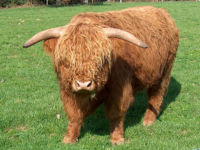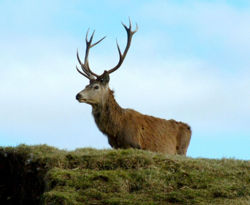Cuerno - Anatomía & Fisiología
Introducción
La queratina de la epidermis, que se engrosa y se ve recubierta por la capa córnea se conoce como el cuerno. . El cuerno es particularmente resistente a los daños mecánicos y químicos. La dermis le confiere su estructura tridimensional y su forma. Ganado bovino, algunos ovinos, cabras y antílopes poseen cuernos y éstos son órganos permanentes. A las razas sin cuernos se les llama descastadas. Los ciervos tienen astas, que son órganos temporales que se desarrollan durante la época de celo y se caen después.
Estructura y Función
Los Cuernos
Los cuernos tienen un centro, el núcleo o proceso cornual que crece a partir del hueso frontal del cráneo. Después de 6 meses de edad, el hueso se vuelve hueco y el espacio que existe en su interior se continua con el seno frontal. La superficie del hueso es porosa y con surcos, se cubre con papilas dérmicas que se continúa con el periostio y la epidermis que queratiniza y forma la capa protectora del cuerno. La sustancia del cuerno es similar a la del casco y es una mezcla de los túbulos y el cuerno intertubular. El cuerno que se forma nuevo en la base es suave y transparente con frecuencia, y se asemeja al periople de la pezuña, confiriéndole un aspecto brillante.
In the neonate, the bone portion is very small, with a thin dermal and epidermal covering. Removal of this covering will prevent the horn from growing and thus remove the requirement for disbudding later in life.
If the skin covering the horn bud is not removed, the horn will continue to grow throughout the animal's life from the base, apically. Growth zones are visible with differing thickness of the keratin layer, relating to the nutritional status of the animal at that time.
The dermis of the horn is supplied by the corunal nerve, which is a branch of the maxillary nerve (CN V). This nerve is often blocked to provide local anaesthesia in the disbudding or de-horning process.
The primary function of horns is to convey social hierarchy. The larger the horns, the higher up the social group the animal is. They also have a thermoregulatory roll in cattle and goats. When the ambient temperature increases, the blood flow through the dermis of the horn also increases, thus facilitating heat loss through radiation from the horn surface.
Antlers
Antlers are the usually large and complex horn-like appendages of most deer species, mostly present in males only, however, for some species such as caribou, are present in both sexes. They consist of bony outgrowths from the skull with no covering of keratin as is found in true horns. Each antler grows from an attachment point on the skull called a pedicle. While an antler is growing it is covered with highly vascular skin called velvet, which supplies oxygen and nutrients to the growing bone; once the antler has achieved its proper size, the velvet is lost and the antler's bone dies. This dead bone structure is the mature antler. Antlers shed after each mating season.
As with horns, the primary function of antlers is to establish social hierarchy. The larger males will be more successful in securing a mate and passing on their genes to future generations.
Antlers also appear to act as large hearing aids. This effect was discovered by researchers George and Peter Bubenik and the findings were published in the European Journal of Wildlife in March 2008. Moose with antlers have far more sensitive hearing than moose without. The pair then studied trophy antlers with an artificial ear, confirming the discovery of the effects on hearing by acting as a parabolic reflector.
Enlaces
http://www.guardian.co.uk/science/2008/mar/21/medicalresearch.animalbehaviour

